The period between the 1890’s and the 1920’s is known in the art world as the Golden Age of American Illustration. A surprising number of people from Hamilton County, Indiana, were contributors to this movement. Until recently, it wasn’t realized how interconnected they were. However, research has now uncovered material showing the extent of their influence on each other.
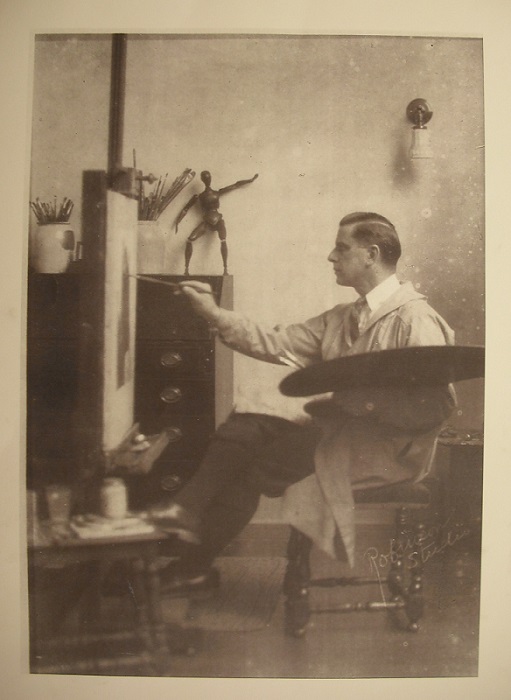
The notion of a common group was first brought up in the Noblesville High School annual in 1904 when they noticed how many alumni were going on to artistic careers. The group got a name from a February 2, 1913, article in the Indianapolis Star which reported on a book that one member had illustrated and used the phrase “Noblesville School Forges to the Front Again.” (This is actually a misnomer – some of the artists were from towns like Carmel. Noblesville was just the largest community in the area.)
The patriarch of the group was Granville Bishop (1831-1902). Bishop was born in Fayette County and his family moved to Hamilton County in 1836. He was a self-taught artist who taught penmanship, painted wagons, and did advertising signs on buildings to supplement his income from painting. He did well enough to support a wife and five children despite being physically handicapped. Unfortunately, few examples of his work exist today. There are two paintings at the Indiana State Museum and a painting of the Indian chief Red Cloud somewhere in the Indianapolis area. According to an interview with George Brehm in the May 1943 issue of the Rainbow, the national magazine for the Delta Tau Delta fraternity, Bishop and an unknown woman watercolorist were credited as the inspirations for some of the next generation of Hamilton County illustrators.
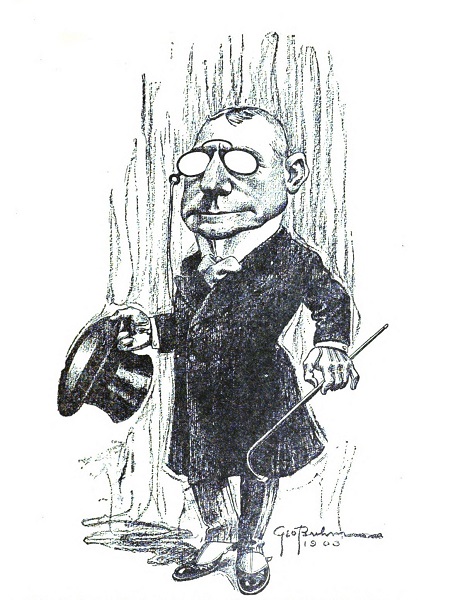
George Brehm (1878-1966) and James Ellsworth “Worth” Brehm (1883-1928) were key members of the group. After graduating from Noblesville High School in 1898 and 1902 respectively, they went to Indiana University and other schools for training in art. George achieved his first local fame by doing caricatures of Hoosier authors. After working at the Indianapolis Star, they moved to New York around 1905 and were soon very successful. George had his first Saturday Evening Post cover in 1906 and Worth had his first cover in 1908. They established separate careers in 1912 when Worth moved to an artist colony in Connecticut. George and his family had an apartment in New York and a summer home on Martha’s Vineyard. Much of the brothers’ work was based on scenes from their boyhood in Noblesville.
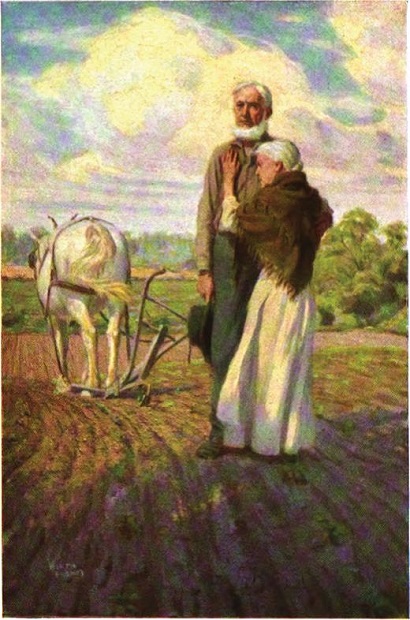
Franklin Booth (1874-1948) and Hanson Booth (1884-1944) were raised in Carmel and followed much the same path as the Brehms. Hanson went to Noblesville High School and was a classmate of Worth Brehm. Franklin Booth would return to Carmel from New York on regular occasions and eventually built a studio behind his family’s home. He is the only one of the four artists who is buried in Hamilton County. He developed a very unique style based on hundreds of pen strokes that would make the finished drawing look like an engraving. Three books have been written about Franklin and his style which, among other things, has become an important influence on modern comic book artists.
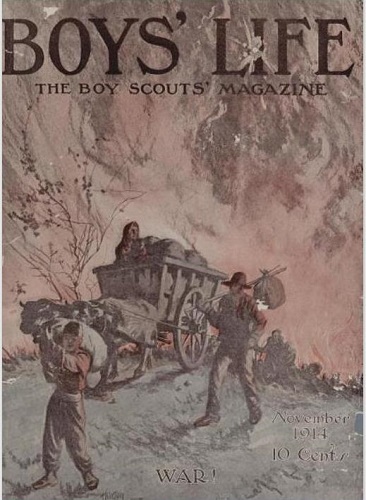
These four artists did illustrations for books, advertisements, and stories in magazines such as Ladies Home Journal, American Magazine, Colliers, and Cosmopolitan. For a short time, they ran an art school together. Their work could also be found in the business magazines of the period. At one point or another, all of them worked with James Whitcomb Riley. George Brehm did work as varied as Saturday Evening Post covers, women’s magazines, Business Week, and Edgar Rice Burroughs stories. Worth Brehm was known for his illustrations of children, and became famous for his images of Penrod, Tom Sawyer, Huckleberry Finn, and others. Franklin Booth did pipe organ advertisements and worked with authors like Theodore Dreiser and Joyce Kilmer. Hanson did not become as well-known as his brother, but did work for pulp adventure magazines, Popular Science, and Boys’ Life.
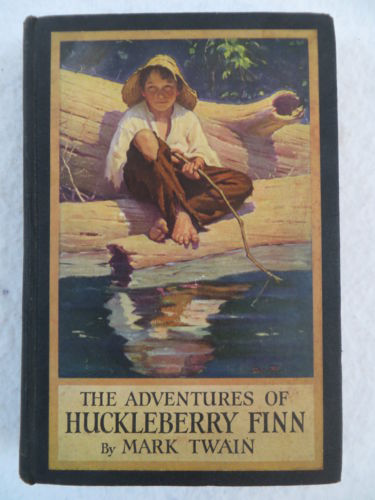
Thomas Blaine Stanley (1884-1965), a classmate of Worth Brehm and Hanson Booth at Noblesville High School, became known for a different kind of drawing. He began as an illustrator, but eventually got a degree in English. He used his degree to teach courses in business English, which eventually developed into the modern profession of Marketing. He wrote two standard textbooks on the subject, which would have been used by the sort of people who populated the fictional HBO series “Mad Men.” Along with this, he used his art skills to become a cartoonist, creating a regular business-oriented comic strip in the magazine Advertising and Selling. It could be considered a “Dilbert” for the 1920’s.
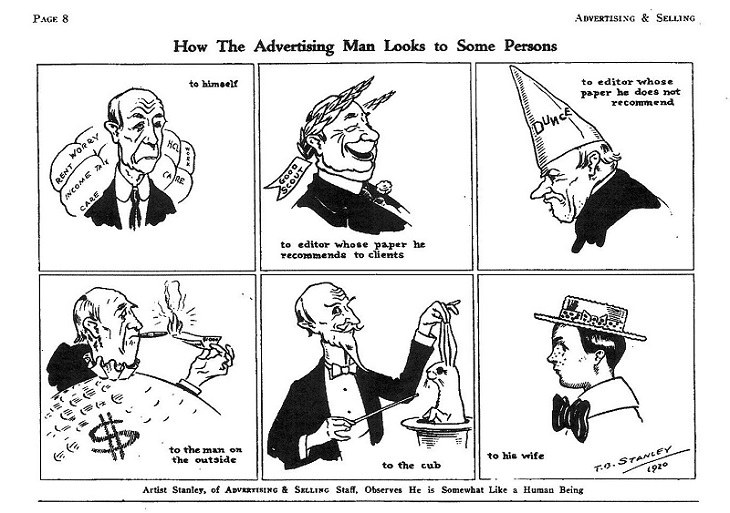
Franklin Booth had protégés – Ralph Applegate (1904-1978) and Booth’s nephew Grant Christian (1911-1989). Applegate was known for creating murals at the 1933 Century of Progress Exposition in Chicago. Christian was a part of the WPA post office mural project and did murals in Indianapolis and Nappanee.
There were also acquaintances of the group who were recognized locally for their art talent, but went into other careers. Worthington Hagerman (1878-1967) worked for the State Department and was Consul in Lisbon, Portugal, during WWII. Buren Mitchell (1886-1955) became a respected college theater teacher in Oregon.
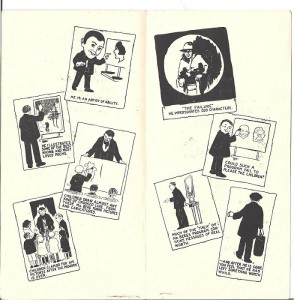
There were other area illustrators, but it’s not known how much they interacted with the group. Russell Berg (1901-1966), did illustration and editorial cartoons, and became known for his Chautauqua performances involving drawing and lecturing. Floyd Hopper (1909-1984) was known regionally for his watercolors, and known locally for his illustration and mural work.
While Hamilton County is not typically thought of as having an artistic heritage, obviously there was inspiration here. The tradition is evident in the ever-developing Carmel Arts and Design District, which features various galleries, showrooms, and the Hoosier Salon. Continuing to research and discuss artists of the past will highlight Indiana’s artistic heritage and, hopefully, encourage others to follow.
Learn more about the state’s rich artistic history with IHB’s state historical markers: William Merritt Chase, William Forsyth, and T.C. Steele.
